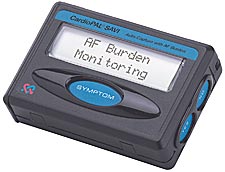New event monitor accurately assesses atrial fibrillation
CardioPAL SAVI AF device provides report on AF burden in an easily interpreted format.
Physicians may soon have a new event monitor at their disposal to accurately assess the severity of atrial fibrillation throughout an extended period of time.
Medicomp Inc., a subsidiary of United Therapeutics Corporation, introduced the AF burden statistical package, available on the company’s ambulatory cardiac monitor, at the Heart Rhythm Society’s 28th Annual Scientific Sessions. The CardioPAL SAVI AF with burden is the first event monitor to provide a full statistical report on the burden of AF in an easy-to-interpret format.
|
|
“This AF burden technology can play a significant role in quantitatively assessing the amount of AF a patient is experiencing independent of symptoms. If physicians had quantitative measures with statistics, graphs and trending and verifiable back-up data, they could make better treatment decisions for their patients. We hope this will ultimately lead to better patient outcomes, including extending lives,” said Dan Balda, MD, president of Medicomp.
AF is a growing epidemic. The degree of burden has been difficult to calculate — one-eighth of all paroxysmal AF is symptomatic, which means the majority is asymptomatic.
“This device will enable investigators to more accurately quantify the true burden of AF before and after interventions, rather than relying simply on a ‘yes/no’ categorical endpoint,” said Thomas M. Beaver, MD, MPH, associate professor in the division of thoracic and cardiovascular surgery at the University of Florida. “I am impressed with this device and believe it will have applications in clinical trials.”
Assessing AF
The CardioPAL SAVI with AF Burden calculates the percentage of time a patient is in AF, how many times a day the patient goes in and out of AF, and the average heart rate. This information is presented in a comprehensive report, which includes statistics, easy-to-interpret histograms and fully verifiable source data.
The technology uses full verifiable data and beat-to-beat independent and concurrent analysis of rate, rhythm, morphology and P-wave abnormalities to accurately capture AF. The algorithm does not require any input from the patient; both symptomatic and asymptomatic AF episodes are automatically captured.
|
Source: Medicomp Inc. |
“We’re helping physicians diagnose and quantify AF. Without the aggressive surveillance that the CardioPAL SAVI with AF burden can provide, physicians may underestimate a patient’s AF burden,” Balda said. “So this also benefits physicians by providing them with the accurate data they need to prescribe proper treatment regimens.”
Patients can wear the monitor for extended periods. It can be used before and after AF treatment to provide physicians with a true AF burden picture. The device is convenient and user-friendly. Right now it is on an event-monitor platform, which typically lasts for up to 30 days.
“Given that new and improved medical, surgical and catheter treatment modalities for AF are being introduced, we focused our development efforts on designing a technology that can properly standardize the measurement of treatment success,” Balda said.
After determining a patient’s baseline AF burden, the physician can initiate treatment and conduct a follow-up AF burden study to determine whether those steps were a successful course or if treatment should be changed.
Opinions of use
Carl J. Pepine, MD, chief medical editor of Cardiology Today, has had hands-on experience with the CardioPAL SAVI in a few patients for whom he could not detect AF using conventional event monitors.
“So far, I’ve been impressed. This device has the ability to detect and identify AF and the ability to quantify its frequency and duration,” Pepine, professor and director of cardiovascular medicine at the University of Florida, said. “It has what appears to be superior abilities to detect AF, and once it is detected, it has an algorithm to calculate the actual status in terms of how much time the patient is having AF.
“I could see high-quality P-wave morphology, which is a shortcoming of many devices.”
Beaver has used the CardioPAL SAVI with AF Burden in a handful of patients; however, these particular patients have all been in sinus rhythm after their AF treatment procedures, so, he has not yet been able to assess patients that have had a reduction in their AF burden.
“We find the device and the company user-friendly and will continue to use it,” Beaver told Cardiology Today.
A look ahead
“Until now,” Pepine said. “We had to rely on patient symptoms or short-term Holter-type monitoring to determine if the patient was having paroxysms of AF. Even when we were fortunate to capture this arrhythmia, we had no way to accurately quantify its duration and frequency. Thanks to this breakthrough technology, more thorough and accurate surveillance is now possible, and this should translate to better patient outcomes.”
Pepine added that although the CardioPAL SAVI has been helpful with his experiences, an independent group needs to conduct further studies to establish the validity of the device.
“The true test is when we see results of an independent study comparing this new device with currently available ones,” he said
The AF burden monitor is in final clinical evaluations and is expected to be available for widespread use in mid-to-late August, according to Balda. Medicomp plans to make this technology available to any physician currently treating patients with AF through its cardiac monitoring service.
Additional studies are currently underway using this monitoring system. Balda said his long-term hope for this technology is for it to play a key role in identifying the trends that will lead experts to decide which AF treatment modality is best suited for specific patient populations. – by Tara Grassia
Dr. Beaver serves on the clinical advisory board of MediComp Inc.
For more information:
- For more information regarding the CardioPAL SAVI monitor, visit www.medicompinc.com/event_monitors.html.


